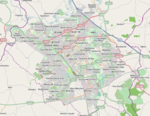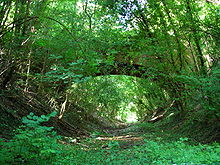- Marlow Branch Line
-
Marlow Branch Line 
A Class 165 DMU runs beside the River Thames between Bourne End and Marlow. This service is known locally as 'The Marlow Donkey'.Overview Type Suburban rail, Heavy rail System National Rail Status Operational Locale Buckinghamshire, Berkshire
South East EnglandOperation Opened 1854 Owner Network Rail Operator(s) First Great Western Technical Track gauge 1,435 mm (4 ft 8 1⁄2 in) Standard gauge Old gauge 2,140 mm (7 ft 0 1⁄4 in) Marlow Branch Line Legend


Chiltern Main Line 




High Wycombe 
Loudwater 
M40 motorway 
Wooburn Green 
A4094 road 


2m 54ch Marlow 


A404 road 


28m 55ch Bourne End 



Bourne End Railway Bridge 
over River Thames 
27m 12ch Cookham 
25m 41ch Furze Platt 





24m 19ch Maidenhead 


Great Western Main Line The Marlow Branch Line is a 7.25-mile (11.67 km) single track railway line between Maidenhead, Berkshire, Bourne End and Marlow, Buckinghamshire, England.[1] Passenger services are operated by First Great Western using Class 165 diesel trains. The line connects to the Great Western Main Line at Maidenhead station, and uses a section of the former Wycombe Railway line to High Wycombe together with the former Great Marlow Railway.
The train that runs on the branch line is known as The Marlow Donkey although the exact derivation of the term is unclear. Karau and Turner say "the trains of pack horses, mules and donkeys carrying goods to the riverside prompted the local people to christen the train on the Great Marlow Railway, the 'Marlow Donkey', a name which survives to this day". However, Anthony Wethered, great-grandson of the first chairman of the company, suggests that it is the name of the line.[2] A third tradition identifies a particular locomotive. A pub in Marlow is named after it.[3][4]
Contents
Train services
The off-peak service is one train per hour in each direction between Maidenhead and Marlow. During morning and evening peak times a half-hourly service is achieved by using two trains: one shuttling between Marlow and Bourne End, and another between Bourne End and Maidenhead. This is possible because Bourne End station has two platforms that may be used simultaneously.
All off-peak trains must stop and reverse at Bourne End, as the line to Marlow has a trailing connection, and the driver must change ends for the second part of the route. Most trains on the line begin and terminate at Maidenhead, but some run through to London Paddington.
The following settlements are served by the branch line:
- Maidenhead
- Furze Platt
- Cookham
- Bourne End
- Marlow
History
The original Maidenhead to Wycombe Branch line
The original Maidenhead to High Wycombe branch line had stops at:-
- Maidenhead (latterly renamed Maidenhead Boyne Hill and effectively replaced by the current Maidenhead station),
- Cookham,
- Marlow Road (latterly renamed Bourne End),
- Wooburn Green,
- Loudwater and
- High Wycombe.
In 1873 an extension was added connecting Marlow station to Bourne End station.
In 1937 Furze Platt station was added on the outskirts of Maidenhead (before Cookham station).
Construction
In July 1846, The Wycombe Railway Company was incorporated by an Act of Parliament. The act authorised the construction of a single line from the original Great Western Railway (GWR) station at Maidenhead, to High Wycombe. Construction began in 1852, and the completed line to High Wycombe, was finally opened on 1 August 1854. The line left the GWR main line at the site of the present Maidenhead station, the first stop of which was Maidenhead (Wycombe Junction), renamed in the 1860s, Boyne Hill. This station was closed on 1 November 1871 upon the opening of the present Maidenhead station. The Wycombe Railway Company was taken over by GWR on 1 February 1867.
In August 1867 the business men of Great Marlow met to discuss a connection with the GWR Wycombe Branch line, at the station then called Marlow Road. The Great Marlow Railway Act was given Royal Assent on 13th July 1968 with an authorized capital of £18,000. Only about one third of this was raised locally and the GWR supplied the remainder. The 2.75 miles (4.43 km) line opened on 27 June 1873, and Marlow Road was renamed Bourne End in 1874 to avoid confusion.[2] The Marlow company maintained the line and supplied the station staff, whilst the GWR supplied and operated the rolling stock. The no. 522, GWR 517 Class 0-4-2 saddle tank locomotive (built at Wolverhampton in 1868), was affectionately known as the Marlow Donkey. No. 522 was rebuilt at Swindon Works in 1884 and similar Metro 2-4-0 class locomotives remained in service until 1935 when autotrains were introduced.[2]
The GWR acquired the remainder of the capital and owned the line from 1897.
Partial closure
In the 1960s the branch began to decline. In July 1962 the steam locomotive was replaced with a Diesel multiple unit. The service was gradually cut back through to 1969, by which time Marlow station had been demolished and replaced by a smaller one on the site of the former goods yard. Loudwater and Wooburn Green lost their ticket offices, Loudwater had been reduced to a single track halt and Cookham lost its passing loop. Finally, on 2 May 1970 the stretch of line from Bourne End to High Wycombe was closed to passengers after the Ministry of Transport refused to include it on the list of unprofitable routes to receive Grant Aid funding from central government (the precursor of the Public Service Obligation grant system introduced in 1974 to provide subsidies for loss-making but 'socially necessary' lines [5]).
Replacement buses
Replacement bus services on the Bourne End to High Wycombe section are:
- Carousel Buses, service 1 [1]
- Arriva Shires & Essex, service 35 [2]
Today
During the 1970s and 1980s, much of the land occupied by the old line was sold off and a number of buildings were built on the path of the old railway. Five of its Seven bridges were demolished Gordon Road, E Gomme Roadway which is now blocked off and the track is now a road into the new housing estate which replaced the old G Plan factory. Others include A40 at Spring Gardens, Bassetsbury Lane, Spring Lane (the one over Bowden lane still remains and at the bottom of Abbey Barn Lane the bridge continues to carry the road over the site of the old line). To prevent future incursion, the path of the old railway line through Bourne End, Wooburn Green, Loudwater and the Wycombe Marsh area of Wycombe, is now listed in the local plan, as set aside as a footpath/cycle route or bus route. Unfortunately Loudwater Station and goods yard together with Bourne End Coal yard siding are now industrial and office units.
The High Wycombe Society, a local conservation group, has campaigned for the last 14 years for the reinstatement of the line, the feasibility of which was confirmed by an engineering survey of the route.[6] In September 2008, Buckinghamshire County Council backed the proposal for reinstatement and called upon a private operator to finance the rebuilding work.[7] The future of the route was raised at a planning hearing in November at which Wycombe District Council identified the prospect of reinstatement as a reason for refusing a planning application to construct housing over the trackbed at Wycombe Lane, Wooburn Green. A previous application for the same development was rejected in 2006 and the Council's decision was upheld on appeal to the planning inspector.[8] In January 2009, the second attempt to build on the route of the railway line was rejected by the Planning Inspectorate which specifically cited the possible future reinstatement of the line as a reason for refusing consent.[9]
The line is not electrified.
Route description
From splitting with the Great Western Main Line at Maidenhead station, it turns North and enters a cutting, going under Grenfell Road and the A4 Castle Hill, passing over the A308 Marlow Road and then a level crossing on Harrow Lane just before its next stop, Furze Platt. From Furze Platt it passes under B4447 Gardner Road, alongside the old Maidenhead Road as it exits the town, continuing through countryside briefly before crossing over the B4447 again before the third stop, Cookham. Immediately after leaving Cookham there is a level crossing on Station Hill, a slight cutting passing under Terry's Lane, up on a viaduct over Cockmarsh before crossing the Thames, and arriving shortly after at Bourne End. Here the driver changes ends for Marlow, turning back along the north bank of the Thames by Spade Oak, passing south of the water treatment works, under the A404 Marlow bypass and finally Marlow station, where the line terminates.
See also
- Great Western Main Line
- First Great Western
- First Great Western Link
- List of closed railway stations in Britain
- Wycombe Railway
References
- ^ 51°34′17″N 0°45′59″W / 51.5713°N 0.7663°W
- ^ a b c Paul Karau, Chris Turner (1987?). The Marlow Branch. Wild Swan Publications, Oxon.
- ^ "The Great Marlow Railway". http://www.mmpa.org.uk/history.html. Retrieved 10 Jun 2010.
- ^ "The Story of the Marlow Donkey". (from Summer 2003 Newsletter). The Marlow Society. 22 April 2003. Archived from the original on 2007-06-22. http://web.archive.org/web/20070622114139/http://www.marlowsociety.org.uk/prognews.htm. Retrieved 2009-08-22.
- ^ The Nationalised Railway 1948-92 The Railways Archive; Accessed 2008-11-20
- ^ Bucks Free Press, "Thank you Elsa for getting Bourne End railway line back on track", 26 September 2008.
- ^ This is local London, "Council support reopening of rail link", 11 September 2008.
- ^ Bucks Free Press, "Railway reopening subject of homes battle", 19 November 2008.
- ^ This is local London, "Developer loses Wooburn Green homes appeal", 26 January 2009.
Further reading
- Mitchell, Vic and Smith, Keith (2002). Branch Lines to Henley, Windsor and Marlow. Middleton Press. ISBN 1-901706-77x.
External links
- National Rail
- First Great Western
- Modern Image Branchlines: Marlow
- Photographic history of the branch line
- Wycombe to Bourne End Railway
Railway stations in the United Kingdom • Railway station categories A B C D E F G H I J K L M N O P Q R S T U V W X Y Z
Transport in Buckinghamshire Road MotorwaysA-RoadsRoman roadsNotable JunctionsMotorway service stationsBeaconsfield · Newport PagnellRail Main linesOther linesMarston Vale Line · London to Aylesbury Line · Metropolitan line · Princes Risborough to Aylesbury Line · Marlow Branch LineClosed linesVarsity Line · Great Central Main Line · Banbury to Verney Junction Branch Line · Brill Tramway · Wycombe Railway · Watlington and Princes Risborough Railway · Cheddington to Aylesbury Line · Aylesbury and Buckingham Railway · Wolverton to Newport Pagnell Line · Bedford to Northampton LineOtherChinnor and Princes Risborough Railway · East West Rail Link · Buckinghamshire Railway Centre · Seer Green rail crash · List of railway stationsAir Waterways RiversCanalsBedford & Milton Keynes Waterway (under construction) · Grand Union Canal · Branches: Slough Arm · Wendover Arm · Aylesbury ArmFootpaths Cycle Paths Related articles Transport in Milton Keynes Road 
Rail Bletchley railway station · Bletchley TMD · Bow Brickhill railway station · East West Rail Link · Fenny Stratford railway station · Marston Vale Line · Milton Keynes Central railway station · Varsity Line · West Coast Main Line · Woburn Sands railway station · Wolverton railway station · Wolverton to Newport Pagnell Line
Bus Buses in Milton Keynes · Arriva Shires & Essex · Milton Keynes Coachway · MK Metro · Stagecoach in Northants · United Counties Omnibus
Water Bedford & Milton Keynes Waterway (under construction) · Cosgrove aqueduct · Grand Union Canal
Other transport Categories:- Rail transport in Buckinghamshire
- Rail transport in Berkshire
- Railway lines opened in 1854
- Railway lines in South East England
Wikimedia Foundation. 2010.



